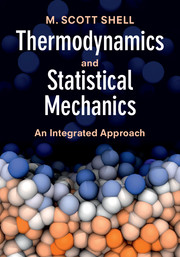Book contents
- Frontmatter
- Contents
- Preface
- Reference tables
- 1 Introduction and guide for this text
- 2 Equilibrium and entropy
- 3 Energy and how the microscopic world works
- 4 Entropy and how the macroscopic world works
- 5 The fundamental equation
- 6 The first law and reversibility
- 7 Legendre transforms and other potentials
- 8 Maxwell relations and measurable properties
- 9 Gases
- 10 Phase equilibrium
- 11 Stability
- 12 Solutions: fundamentals
- 13 Solutions: advanced and special cases
- 14 Solids
- 15 The third law
- 16 The canonical partition function
- 17 Fluctuations
- 18 Statistical mechanics of classical systems
- 19 Other ensembles
- 20 Reaction equilibrium
- 21 Reaction coordinates and rates
- 22 Molecular simulation methods
- Index
- References
14 - Solids
Published online by Cambridge University Press: 05 April 2015
- Frontmatter
- Contents
- Preface
- Reference tables
- 1 Introduction and guide for this text
- 2 Equilibrium and entropy
- 3 Energy and how the microscopic world works
- 4 Entropy and how the macroscopic world works
- 5 The fundamental equation
- 6 The first law and reversibility
- 7 Legendre transforms and other potentials
- 8 Maxwell relations and measurable properties
- 9 Gases
- 10 Phase equilibrium
- 11 Stability
- 12 Solutions: fundamentals
- 13 Solutions: advanced and special cases
- 14 Solids
- 15 The third law
- 16 The canonical partition function
- 17 Fluctuations
- 18 Statistical mechanics of classical systems
- 19 Other ensembles
- 20 Reaction equilibrium
- 21 Reaction coordinates and rates
- 22 Molecular simulation methods
- Index
- References
Summary
General properties of solids
The term “solids” denotes materials that generally have the following properties. From a microscopic perspective, the molecules in a solid are in a condensed, closely packed state, and they vibrate around a fixed equilibrium position. That is, molecules can be considered tethered near a specific location in space, since their diffusion is very slow relative to the time scales of observation. From a macroscopic point of view, solids have an elastic modulus. This means that the application of a stress to the material produces a strain as well as an opposing force that tends to return the solid to its original, unstrained state once the stress is removed. This contrasts with viscous behavior in which an applied stress results in continuous, permanent deformation, such as the flow of a liquid.
Generally speaking, there are two primary classes of solids. Crystalline solids are equilibrium states of matter in which the microscopic structure has a well-defined geometric pattern with long-range order: a crystalline lattice. In contrast to crystals, amorphous solids have no long-range order, meaning that they lack a lattice structure and regular positioning of the molecules. Glasses and many polymeric materials are amorphous. Frequently these systems are not at equilibrium, but evolve very slowly in time and are metastable with respect to a crystalline phase. They might be considered liquids of extremely high viscosity that are slowly en route to crystallization. However, typically the time scale to reach equilibrium is so long (perhaps longer than the age of the universe) that for all practical purposes the amorphous state appears solid and stable. Thus, in an empirical sense, often we can treat such systems as in quasi-equilibrium.
- Type
- Chapter
- Information
- Thermodynamics and Statistical MechanicsAn Integrated Approach, pp. 280 - 304Publisher: Cambridge University PressPrint publication year: 2015

